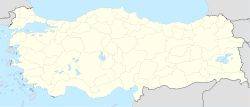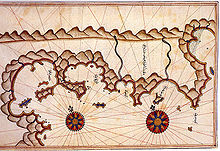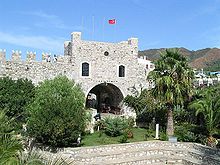- Marmaris
-
Marmaris Beaches of Marmaris on the Turkish Riviera Location of Marmaris Coordinates: 36°51′N 28°16′E / 36.85°N 28.267°ECoordinates: 36°51′N 28°16′E / 36.85°N 28.267°E Country  Turkey
TurkeyRegion Aegean Province Muğla Government - Mayor Muhammet Ali Acar (CHP) Time zone EET (UTC+2) - Summer (DST) EEST (UTC+3) Postal code 48700 Area code(s) (0090)+ 252 Licence plate 48 Website www.marmaris.bel.tr Marmaris is a port city and a tourist resort on the Mediterranean coast, located in southwest Turkey, in Muğla Province.
Marmaris' main source of income is tourism. Little is left of the sleepy fishing village that Marmaris was just a few decades ago after a construction boom in the 1980s. Marmaris still retains its charm due to its exceptional location between two intersecting set of mountains by the sea. The town's population is 28,660 (2000) and is estimated to make a peak of 300,000 - 400,000 people during the tourism season. Marmaris' nightlife rivals anything on the Turkish coast.
It is also a centre for sailing and diving, possessing two major and several smaller marinas. It is a popular wintering location for hundreds of cruising boaters. It is served by the nearby Dalaman Airport.
Contents
Climate
Marmaris has a Mediterranean Climate characterised by a hot and humid summer and cool, rainy winter. Showers and rain are very unlikely between May and October.
Summers are hot and humid, and temperatures can reach over 40°C sometimes during heatwaves in July and August. October is still warm and bright, though with spells of rain, and many tourists prefer to visit in the early autumn, especially in September, because the temperatures are not as hot.
Winters are mild and wet. Winter is the rainy season, with major precipitation falling after November. The annual rainfall can reach to 1,232.7 milimetres (48.531 in); the rainfall is concentrated during scattered days in winter falling in heavy cloudbursts which cause flash floods sometimes in flood prone areas.[1]
Climate data for Marmaris Month Jan Feb Mar Apr May Jun Jul Aug Sep Oct Nov Dec Year Record high °C (°F) 21.0
(69.8)24.0
(75.2)28.4
(83.1)31.0
(87.8)36.0
(96.8)42.2
(108.0)45.2
(113.4)42.6
(108.7)40.7
(105.3)39.0
(102.2)31.6
(88.9)22.2
(72.0)45.2
(113.4)Average high °C (°F) 15.1
(59.2)15.3
(59.5)17.6
(63.7)20.9
(69.6)25.9
(78.6)31.4
(88.5)34.5
(94.1)34.3
(93.7)30.8
(87.4)25.9
(78.6)20.4
(68.7)16.4
(61.5)24.04
(75.28)Average low °C (°F) 7.0
(44.6)7.0
(44.6)8.6
(47.5)11.5
(52.7)15.6
(60.1)20.1
(68.2)23.1
(73.6)23.2
(73.8)20.0
(68.0)15.8
(60.4)11.4
(52.5)8.5
(47.3)14.32
(57.77)Record low °C (°F) −2.4
(27.7)−3.4
(25.9)−1.2
(29.8)1.4
(34.5)8.0
(46.4)12.5
(54.5)16.8
(62.2)16.7
(62.1)12.8
(55.0)5.5
(41.9)1.4
(34.5)−1
(30.2)−3.4
(25.9)Precipitation mm (inches) 230.7
(9.083)170.0
(6.693)120.8
(4.756)61.1
(2.406)27.8
(1.094)15.3
(0.602)23.4
(0.921)7.9
(0.311)24.5
(0.965)80.9
(3.185)180.4
(7.102)289.9
(11.413)1,232.7
(48.531)Avg. rainy days 13.7 11.9 9.4 7.7 4.4 2.7 1.9 1.0 2.1 5.5 9.1 13.6 83 Sunshine hours 127.1 137.2 192.2 222 285.2 324 344.1 328.6 273 217 144 111.6 2,706 Source: Devlet Meteoroloji İşleri Genel Müdürlüğü [2] History
Although it is not certain when Marmaris was founded, in the 6th century BC the site was known as Physkos (Ancient Greek: Φύσκος) and considered part of Caria.
According to the historian Herodotus, there had been a castle on the site since 3000 BC. During the Hellenistic Age, Caria was invaded by Alexander the Great and the castle was besieged. The 600 inhabitants of the town realised that they had no chance against the invading army and burned their valuables in the castle before escaping to the hills with their women and children. The invaders, well aware of the strategic value of the castle, repaired the destroyed sections to house a few hundred soldiers before the main army returned home.
The next important event during the history of Marmaris was almost two thousand years later, in the mid-fifteenth century, when the Ottoman Empire began to rise after the efforts of Sultan Mehmet II, who succeeded in conquering and uniting under one banner the various tribes and kingdoms of Anatolia. Some of his greatest difficulties came from the Knights of St. John, who occupied the Dodecanese Islands. Based in Rhodes, the Knights had fought for many years; they were able to withstand the onslaughts of Mehmet II until a succeeding and more powerful Sultan came on the scene.
Marmaris Castle was rebuilt from scratch in 1522 by the Ottoman sultan Süleyman the Magnificent when he had set out for his campaign on Rhodes, for which Marmaris served as a base. Lord Nelson and his entire fleet sheltered in the harbour in 1798, en route to Egypt to defeat Napoleon’s armada at the Battle of Aboukir[3].
Since 1979, renovation work has been continuing at the castle, in order to restore it back to original condition. Under the auspices of the Ministry of Culture, the castle was converted into a museum. There are seven galleries, of which the largest is being used as an exhibition hall and the courtyard is decorated with seasonal flowers. Built at the same time as the castle in the bazaar, there is also a small Ottoman caravanserai built by Süleyman's mother Ayşe Hafsa Sultan.
Gallery
Twin towns - sister cities
Marmaris has nine sister cities
 Gujrat, India
Gujrat, India Monaco
Monaco Lezhe, Albania
Lezhe, Albania Kloulklubed, Palau
Kloulklubed, Palau Liege, Belgium
Liege, Belgium Sri Jayawardenapura Kotte, Sri lanka
Sri Jayawardenapura Kotte, Sri lanka Dzerzhinsk, Russia
Dzerzhinsk, Russia L'Aquila, Italy
L'Aquila, Italy Hasroun, Lebanon
Hasroun, Lebanon
See also
Resources
External links
Municipalities: 
National parks of Turkey Aegean Region Black Sea Region Alacahöyük · Altındere · Hatila Valley · Kaçkar Mountains · Karagöl-Sahara · Küre Mountains · Mount Ilgaz · YedigöllerCentral Anatolia Region Eastern Anatolia Region Marmara Region Mediterranean Region Altınbeşik Cave · Beydağları Coast (Olympos) · Güllük Mountain (Termessos) · Karatepe-Aslantaş · Kızıldağ · Köprülü Canyon · Lake Kovada · Saklıkent CanyonSoutheastern Anatolia Region Categories:- Districts of Muğla
- Marmaris
- Turkish Riviera
- National parks of Turkey
- Mediterranean port cities and towns in Turkey
- Populated places in Muğla Province
- Muğla Province
Wikimedia Foundation. 2010.






